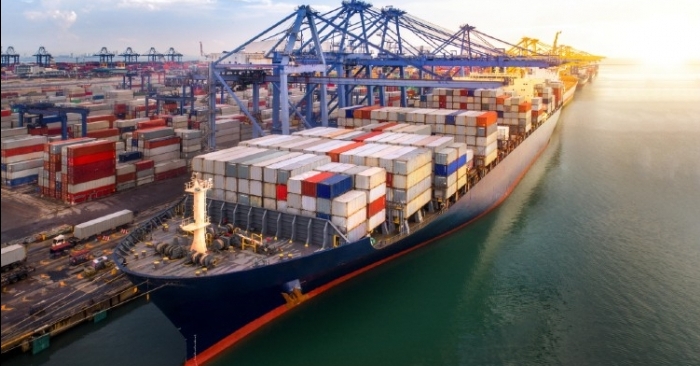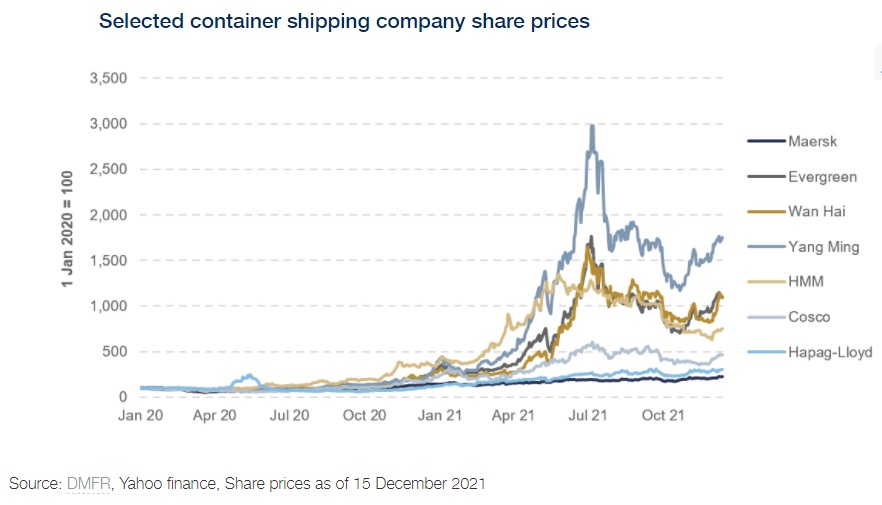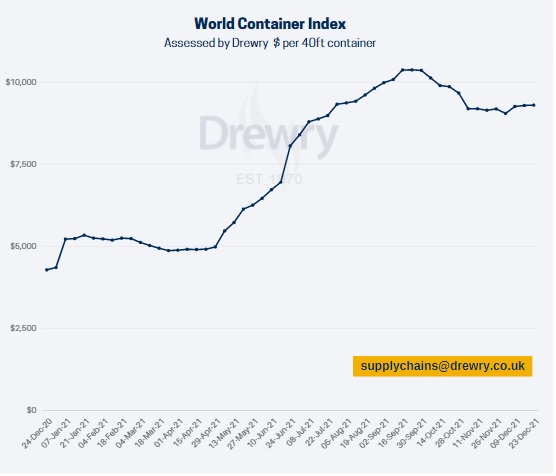Container carriers’ profits now seen at $190 billion, Drewy says; another stock rally seen in 2022
Given the supply chain logjams and rising threat of the Omicron virus, global shipping consultancy Drewry has once again upgraded its annual profitability forecast of container carriers for 2021 from its previous guidance of $150 billion to $190 billion at a margin of approximately 43 percent.

Given the supply chain logjams and rising threat of the Omicron virus, global shipping consultancy Drewry has once again upgraded its annual profitability forecast of container carriers for 2021 from its previous guidance of $150 billion to $190 billion at a margin of approximately 43 percent.
"The smoother earnings forecast rationale stems from a pivot away from the volatile (and likely retreating) spot market towards longer-term contracts that are expected to be signed at significantly higher levels in upcoming negotiations," Drewey said in its latest update. "This will ensure high profits for the global container shipping sector that will continue to generate very handsome spill-over benefits for stock investors through both soaring share prices and generous dividends."
Drewry Maritime Financial Research (DMFR), the investment research arm of Drewry, remains bullish about the continued high stock prices and rising profitability in the booming container carrier sector.
"In an analysis in the December edition of Drewry’s Container Forecaster, DMFR analyses factors supporting its conclusion that equity investors should ‘stay put’ in the sector, and that annual carrier industry profits will rise again in 2022."
Asian liner operators were the top performers with Yang Ming rallying 1,583 percent (as of mid-December 2021) followed by Evergreen Marine’s gain of 987 percent and Wan Hai’s 976 percent.

HMM generated returns of 621 percent. "Modest growth was seen in Europe where Hapag-Lloyd shares rallied 192 percent and Maersk by 123 percent."
Data from 12 carriers suggests cumulative debt has reduced by $3.5 billion between end-December 2020 and end-September 2021 to $73.2 billion. "Quite a number of carriers are in a net cash position - meaning their cash balance exceeds total debt, a rarity for the sector."
With debt dropping, debt/equity ratio - a key matrix for stocks - is at 0.54x by the end of September, says Nilesh Tiwary, Sr. Manager, DMFR who authored the report.
So, is debt refinancing also happening to reduce interest costs? "Yes, Hapag Lloyd recently did," Tiwary said. "Green financing (via green bonds) is gaining traction."
Major shipping lines are also buying back shares. Maersk’s directors have approved an additional share buyback programme of DKK 32 billion ($5 billio) over 2024 and 2025, bringing the total of outstanding share buyback programmes to DKK 64bn ($10 billion) from 2022 to 2025. "Cosco announced on December 6 that the board proposed a share repurchase mandate up to 10 percent of its A- and H shares, pending shareholder approval."
Maersk has spent almost $4 billion to acquire LF Logistics & Senator. CMA CGM almost a similar amount. MSC is spending around $6billion to buy the Africa logistics business of Bollore Logistics. Are M&As the way forward for large ocean carriers? How will it affect stock prices? "Yes, all the companies you named are trying to verticalize by getting big into 3PL/4PL logistics," says Tiwary. "Their basic aim is to provide a one-stop solution for shippers. So, expect more M&As in the areas of logistics. Stock prices will react positively so long as companies are making profits and have enough money to fund these acquisitions. Stock prices are also strongly correlated to container spot freight rates (e.g. Drewry’s World Container Index (WCI)."
Given strong stock performances and the assumption that spot freight rates have peaked, investors may be tempted to exit the space. However, we see three key reasons to stay positive about the sector:
- Omicron has increased the risk of extended supply chain disruption, which could prop up spot rates for longer and assist contract negotiations;
- Strong free cash flow (FCF) in the next two years should lift share prices. Maersk has estimated that the group is expecting FCF of about $14.5 billion by the end of 2021. Based on that, we can safely presume that the industry will report a free cash flow in excess of $100 billion for 2021 after reporting $68 billion in 9m21 (cumulative of 11 carriers); and
- Returns on invested capital to be above the weighted average cost of capital (WACC) for a more sustained period. We think the current congestion is an opportunity for shipping companies to obtain better (and longer) contract terms from shippers who will want to ensure their cargo can be moved and avoid high volatility in prices. This will mean sustained profits and higher returns on invested capital versus WACC.
Drewry WCI up marginally this week, 119 percent higher than last year
Drewry’s composite WCI increased marginally to $9,304.05/40ft container this week, and remains 119 percent higher than a year ago.
The average composite index of the WCI, assessed by Drewry for year-to-date, is $7,555/40ft container, which is $4,756 higher than the five-year average of $2,799 per 40ft container.

Rates on routes like Shanghai–Rotterdam, Shanghai–Los Angeles,Los Angeles–Shanghai and Shanghai– New York were around previous week's level.
Drewry expects rates to remain steady in the coming week.

Jyothi Shankaran
Associate Editor, STAT Media Group. He has worked with IndiaSpend, Bloomberg TV, Business Standard and Indian Express Group. Jyothi can be reached at jyothi@statmediagroup.com


